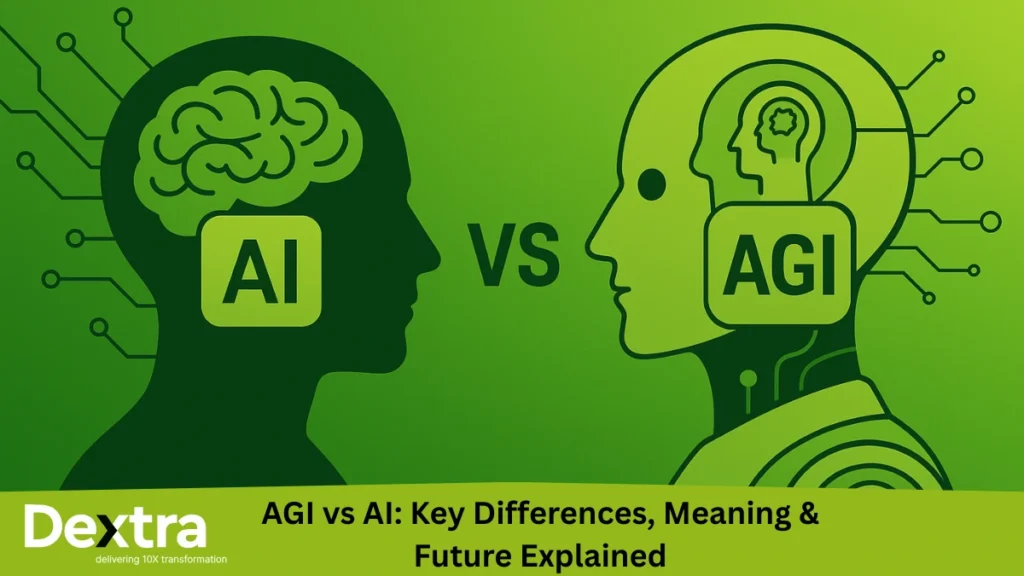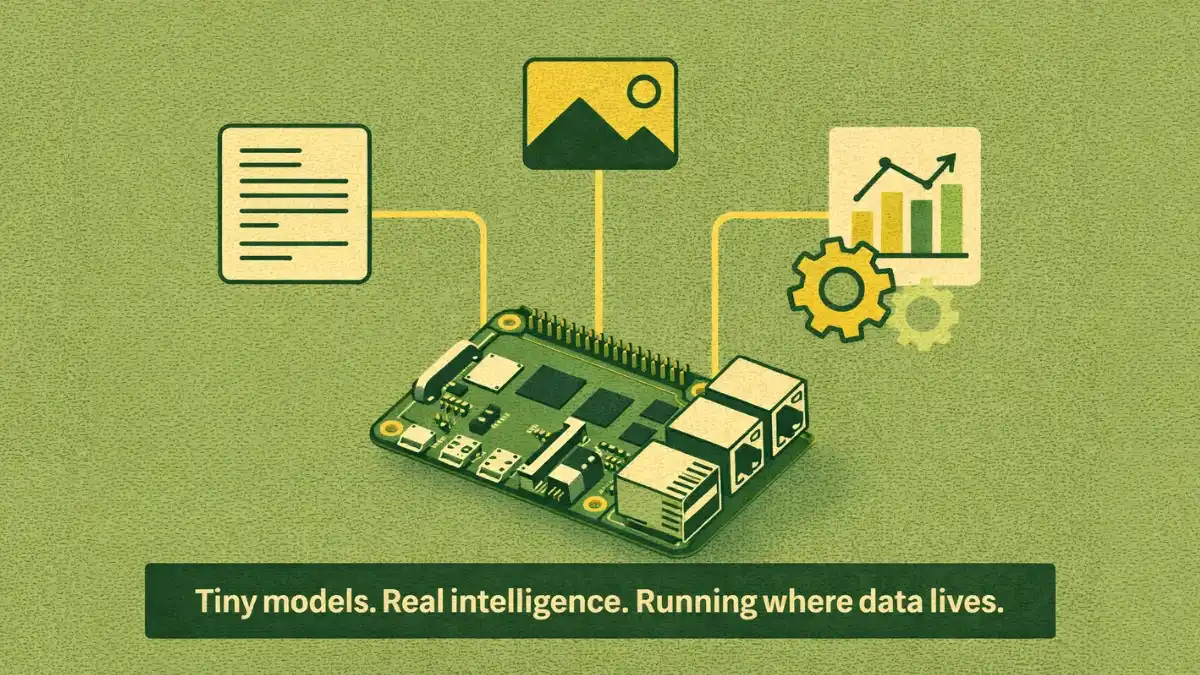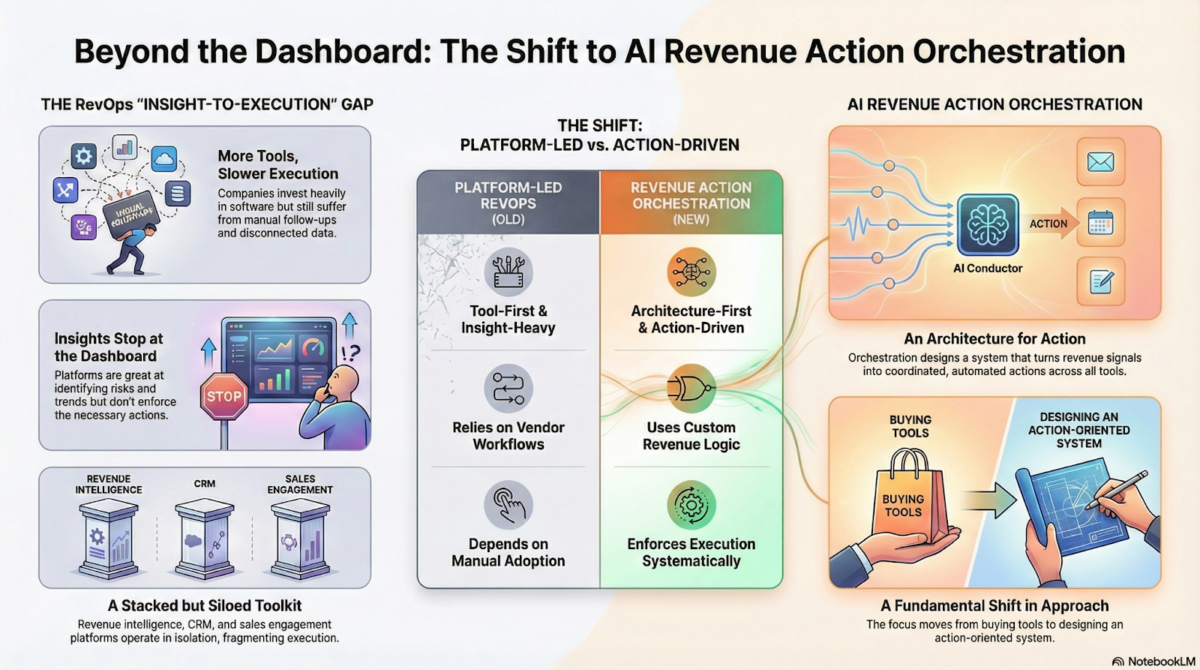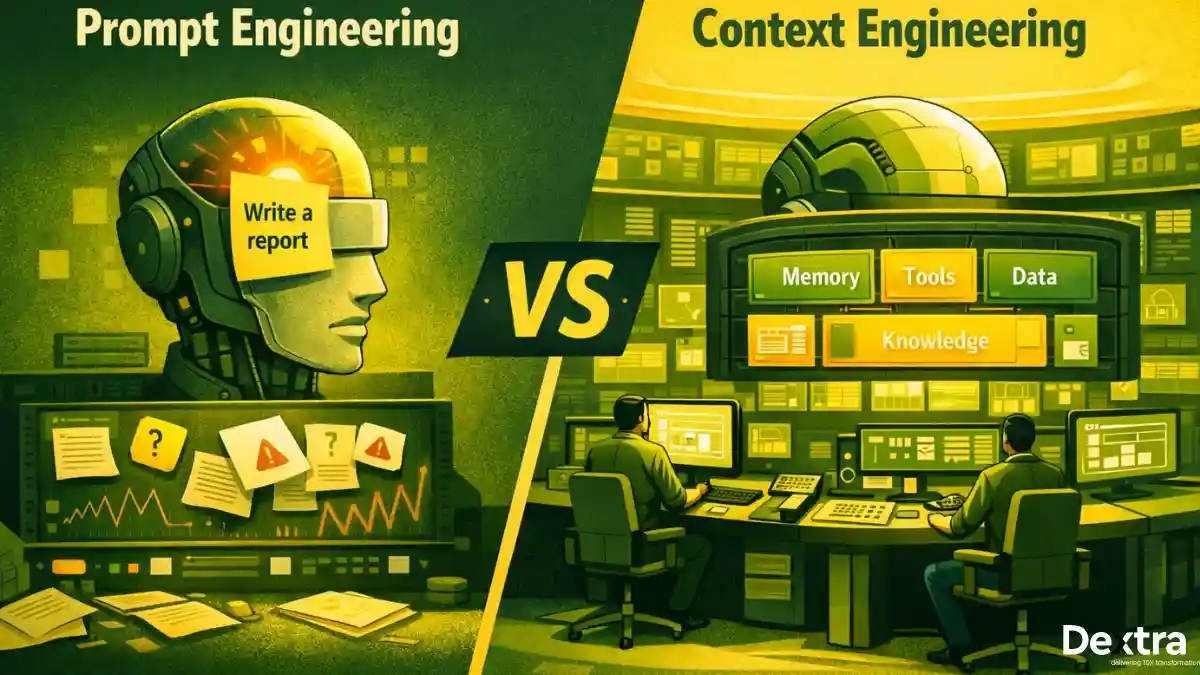Artificial Intelligence (AI) is influencing every element of our lives: how we live, work, and think. Daily, we experience basic forms of AI in the form of voice assistance and spam filtering, with powerful and complex forms of AI to come in robotics, diagnostics in the healthcare sector, and automated customer service.
A McKinsey study in 2024 found that AI has more than doubled in adoption since 2017, with 72% of organizations using at least one AI tool in their operations. While AI may seem incredibly advanced, we’re only scratching the surface of its full potential.
The next technological advancement occurs within a space that is far more complex – Artificial General Intelligence (AGI). This extensive guide will provide a detailed overview of agi vs ai, including their differences, applications, and challenges, and outline the significant challenges moving forward, while including how Dextralabs, a trusted partner for AI transformation, can help your business navigate the new wave of AGI technology with strategic AI solutions to meet your business goals.
Custom or Off-the-Shelf? Let’s Build What’s Right for You
Explore Our Custom AI Implementation Services
Introductory Concepts: What is AI?
Artificial Intelligence (AI) is usually defined as any machine or software that can perform tasks that humans do and that exhibits a factor of human intelligence: learning, recognizing patterns, reasoning, and decision making.
Stages of Development in AI
- Reactive Machines: They only respond to specific inputs. Example: IBM’s Deep Blue
- Limited Memory AI: Can learn from historical information. Example: Self-driving cars
- Theory of Mind (Future): AI can understand emotional and social behavior.
- Self-aware AI (Hypothetical): A future idea where AI feels and knows its own existence.
Currently, AI systems predominantly exist in the Reactive and Limited Memory levels. They can perform a few functions well, and they do not exhibit AGI’s complex reasoning, awareness, or insight into emotion.
This limitation is central to the agi vs ai debate, where AI is narrowly defined and related, task-oriented intelligence, while AGI is a level of intelligence that simulates a human mind, a flexible intellect that can think and generalize about problems, and is aware of itself.
How AI Is Solving Real Problems?
- Healthcare: predictive diagnostic + analytics, robotic surgery
- Manufacturing: predictive maintenance, quality control
- E-commerce: product suggestions, dynamic price plans
- Finance: fraud identification, algorithmic trading
- Transportation: traffic optimization, autonomous vehicles
If your company is thinking about establishing or augmenting AI-based capabilities, working with an AI-powered digital transformation firm like Dextralabs is advantageous because we provide tailored solutions that achieve real-world outcomes.
What is Artificial General Intelligence?
Before diving deeper into AGI, it’s important to ask: what is intelligence in the first place? Intelligence refers to the ability to learn, reason, and solve problems—skills that AGI aims to replicate at a human level.
However, what is AGI in AI? To better understand AGI, let us first define what AGI is not; we should eliminate traditional AI from the equation.
AGI meaning refers to Artificial General Intelligence and is described as machines that can understand, learn, and apply intelligence to a variety of tasks, like a human. Narrow AI (or weak AI) is programming that is focused on completing a specific task, like facial recognition, or that same programming may be used as a translator; whereas AGI systems are capable of the spectrum of cognitive abilities humans are capable of.
Some users even wonder, “What is my AGI?”—often confusing it with tax-related terms—but in AI, AGI stands for Artificial General Intelligence.
In short, AGI in AI refers to the next experience: a general intelligence that can think, reason, learn, and even feel. AGI systems would not just be able to solve one problem; AGI would solve any problem, like a human approaches a problem, regardless of how it was originally programmed. This forms the core
AGI from Multiple Perspectives:
Defining AGI cannot rely solely on a single definition. In this section, we are going to examine AGI from four perspectives that are separate and related. This holistic view deepens the agi vs ai comparison.
1. Functional AGI (Capability-Based AGI)
This perspective defines AGI by the ability to perform across multiple tasks. A functionally general AI system could solve math problems, write papers, drive a car, cook meals, and have deep conversations, with the same level of proficiency.
It might not only replicate a task but also understand the context, learns new rules governing a task, and draw from previous knowledge from multiple domains, similar to how we operate as humans using our brains.
2. Cognitive AGI (Human Reasoning Replication)
This method of AGI is oriented around how AGI thinks, rather than what AGI does. Cognitive AGI attempts to recreate the structure and behavior of the human mind, including reasoning, perception, memory, and language understanding. Understanding AGI’s meaning from a cognitive perspective involves mimicking human reasoning, perception, and decision-making.
Cognitive AGI proposes to simulate the thinking process, enabling the machine to solve problems in a human-like fashion, giving clearer insight into what is AGI in AI when seen from a psychological lens.
3. Self-Learning AGI (Autonomous Adaptation)
At this stage, we’re really talking about learning and developing. A self-learning AGI would potentially be able to improve itself without human aid, and would adapt to changing environments, learn new things, and change its behavior in real-time.
This is like a child developing new experiences, not just via instruction. Self-learning AGI could teach itself totally new skill sets; it will be beyond the current machine learning systems, where the data is fed to the system by humans.
4. Philosophical AGI (Self-Awareness and Emotion)
One of the more difficult and controversial opinions might be whether AGI can have a conscious state or emotional intelligence. This philosophical perspective asks whether machines can feel emotions, have self-awareness, or develop a moral conscience.
At present, we have systems that can simulate emotions. Someday, AGI may be able to actually feel emotions. However, if machines become aware of themselves, there exists an ethical concern: do they have rights? Are they trustworthy?
How Does AGI Work?
To differentiate between AI and AGI, it is necessary to lift the hood and get some idea of how AGI technology may work. Understanding AI Vs AGI mechanisms like continual learning, cognitive models, and meta-learning is critical for businesses looking to adopt future-ready tech.
This vision rests on hybrid models, advanced learning systems, and experimental research that combines cognitive sciences and computer engineering.
Learning Mechanisms in AGI
AGI meaning also includes the ability to learn continuously and adaptively, just like a human child who learns and progresses with their own experience.
Continual Learning:
AGI systems must learn throughout their lifetimes, retaining knowledge from prior experiences and learning new information without forgetting what they had previously learned, a problem found in today’s AI called catastrophic forgetting. The benefit of an ongoing learning process allows AGI to continually build a lifelong knowledge of the world.
Cognitive Models:
Cognitive Models are models for AGI that generally describe the processes the human brain undertakes when processing information. AGI research often refers to cognitive models to develop models of perception, memory, decision, and reasoning that closely match the way humans think and act.
Meta-Learning (Learning to learn):
Meta-learning allows AGI to advance, not just learn data, but improve its process of learning. Over time and with continued learning, AGI can become better at learning. With little data, AGI systems can apply and adapt to novel experiences similarly to how humans learn. This process reveals a fundamental aspect of what is agi in ai, systems that improve their own ability to learn.
2. Possible Architectures for AGI
AGI technology does not have a singular design solution. Researchers are investigating a number of hybrid architectures that combine symbolic reasoning, neural networks, and memory systems to replicate the flexibility of human intelligence—an essential focus in the agi vs ai discourse.
Symbolic Reasoning:
A classic AI approach where logic and rules are used to make decisions. It is powerful for doing structured tasks, but lacks the flexibility needed in uncertain environments
Neural Networks:
Deep Learning (such as the models that underlie GPT and other large language models) is great at pattern recognition and generalization, but lacks the structured reasoning of human reasoning.
Memory Models:
AGI systems have long-term memory and working memory modules that make access to acquired knowledge contextually—this is important to build a coherent worldview.
3. Examples of Early AGI Research
There are a few noteworthy projects that highlight possible paths towards AGI conception:
OpenCog:
An open-source platform that facilitates the integration of logic reasoning, natural language understanding, and machine learning methodologies. Its goal is to create systems that can self-evolve over time.
DeepMind’s Gato:
Gato is a generalist agent performing over 600 tasks using one neural network, with tasks ranging from playing Atari games to controlling a robot arm, indicating an early form of cross-domain intelligence.
Stanford’s Self-Learning Agents:
These systems investigate agents that independently acquire knowledge, reason, and learn to adapt their behavior without encoding instructions.
Business Use Cases: AI Today vs AGI Tomorrow
Artificial Intelligence (AI) has already changed the way organizations are functioning today, AGI meaning extends to a form of intelligence that will fundamentally change and shape the future of enterprise at an even higher level. To understand how to deliver, apply, and leverage AI vs AGI, it first makes sense to analyze how AGI is in both current and future case uses.
The comparison between what AI is capable of today and AGI’s possibilities of tomorrow draws a very clear path forward for organizational innovation, transformation, and scale. It also helps leaders better grasp what is AGI in AI and how it applies to their future strategy.
AI Applications Today (Narrow AI):
Currently, most businesses are using Narrow AI— a specialized form of AI designed to complete specific tasks. These systems have no self-awareness or real understanding of the world outside their boundaries, yet can solve problems with predictive techniques accurately. This is how Narrow AI is applied today in different industries:
1. Customer Support Bots
AI-powered chatbots are pushing the pack as the most widely adopted applications in customer service. They can respond to FAQs, fulfill requests, and refer to complex questions that require human examination and response.
Customer support chatbots work any time and reduce response time and cost to a business. Natural Language Processing (NLP) is now in a good place in providing an understanding of a customer’s intent and providing a personalized response that adds real value to the user experience.
2. Fraud Detection
Banks and fintech organizations apply machine learning algorithms to identify fraudulent transactions in real-time. These AI systems consider historical transaction data, spending patterns, and user behavioral data to identify anomalies. AI systems don’t “understand” fraud, like humans do, but an ability to detect suspicious activities based on records that have drastically reduced financial losses.
3. Predictive Analytics
Businesses are employing AI technology to predict trends, for demand planning, and to manage inventories. AI can analyze immense data sets and is therefore better at anticipating human activity, optimizing supply chains, and recommending a company strategy.
Marketing teams use predictive models to be more effective in targeting campaigns or messages. This can increase Return on Investment (ROI) and customer retention by optimizing the overall campaign, rather than just the targeting.
Future AGI Impact
AGI (Artificial General Intelligence) stands apart from today’s AI by its ability to replicate human-like cognitive functions. AI systems today are considered ‘narrow’ (or weak), because they are only able to perform and adapt knowledge based on experience, like a human. When completely developed, AGI will alter the way businesses actually function.
1. Strategic Consulting
Think about an AGI capable of evaluating entire market landscapes, forecasting disruption, and recommending strategic pivots rooted in an understanding of economics, psychology, geopolitics, and technology.
AGI may replace or augment high-end consulting firms not only by analyzing data, but by reasoning through uncertain situations and offering actionable insights–with the capability to reason through ambiguous scenarios.
2. Scientific Research Automation
AGI would help focus and accelerate R&D like never before. In pharmaceuticals, for example, AGI can hypothesize, simulate, and test novel drug formulations with minimal human action. It can read and interpret research papers, generate new theories, and even design experiments. It would dramatically shrink the time and cost of the discovery process and drive innovation at exponential rates.
3. Autonomous Enterprise Planning
Although AI can handle segments of enterprise resource planning (ERP), AGI could autonomously run full enterprises.
From human resources to finance to logistics, AGI could analyze internal and external data, recommend ideal decision-making, and potentially shift an entire organization’s structure based on real-time market conditions. This level of holistic, adaptive planning is beyond the capabilities of current AI.
Comparison Table: AI Use vs AGI Potential
| Feature / Application | AI Today (Narrow AI) | AGI Tomorrow (General AI) |
| Intelligence Scope | Task-specific and rules-based | Broad understanding with human-like capabilities |
| Customer Support | Stand-alone chatbots that respond to simple requests | Emotionally intelligent agents provide full support |
| Fraud Detection | Detect patterns that follow anomalies | Contextually aware reasoning that realizes evolving patterns of fraud |
| Predictive Analytics | Used historical data patterns | Adaptive modeling with real-world awareness |
| Strategic Decision-Making | Assisted tools based on pre-set parameters | End-to-end strategic consulting with cross-domain reasoning |
| Scientific Research | Data crunching and simulations | Developing theories through experimentation and discovery |
| Business Planning | Department-level optimizations | Operating the business autonomously |
| Learning Capability | Static models requiring retraining | Dynamic learning and generalization across any field |
How can AGI vs AI Benefit Your Business?
Understanding AI Vs AGI is essential for business leaders who want to maintain their competitive position. Today’s AI provides organizations with innovative ways to optimize their business model, allowing them to improve their operations, reduce their costs, and make informed analytical decisions based on their existing data. Utilizing AI allows organizations to automate routine tasks, freeing up human resources for more complex roles.
AGI, on the other hand, can change the entire notion of “work” and decision-making. AGI could act as a full-time CEO, strategy officer, researcher, and innovator all at once. Because AGI can imitate human intelligence and exceed human intelligence, AGI would empower organizations to tackle organizational challenges with unprecedented creativity, speed, and scale.
Yet we must be critical of the fact that while AI is already embedded into every business model and providing business value, AGI is theoretical and poses significant risks and ethical challenges. The granting of AGI in business is going to require new governance structures, repurposing the workforce, and stricter implementation.
AGI vs generative AI
Generative AI models comprise the vast majority of today’s widely recognized AI technologies — ChatGPT, Midjourney, DALL·E, etc. They can produce varied types of content, like text, images, music, etc, all from massive datasets.
But are they AGI?
No. Generative AI is still part of ANI. It works by:
- Recognizing patterns and recreating them
- Producing outputs by applying predictions from data probabilities
- Using a human-curated dataset
AGI, on the other hand:
- Understands context and AGI meaning at a deeper level
- Learns from experience and is self-learning
- Utilizes logic and emotion in real-time and dynamically
So, even by the AGI vs generative AI comparison, generative AI is a powerful model, but it is limited. Generative AI provides simulation of knowledge, while AGI provides knowledge understanding.
Is ChatGPT AGI?
One question that comes up is: Is ChatGPT AGI?
The answer is No. ChatGPT seems smart, but it’s still just a large language model. It:
- Lacks true comprehension of the content it generates.
- Cannot create independent thoughts
- Has no memory beyond one session (in the majority of consumer editions)
- Does not exhibit emotional intelligence
AGI would be able to:
- Identify new problems and solve them intuitively
- Identify real-time changes in the environment
- Express curiosity and motivation
ChatGPT might look like AGI, but it’s simply a smart tool. This popular misconception underlines the need to understand agi vs ai in practical applications.
AGI Examples from Fiction and Theory
While there are no live examples of AGI today, there are, in theory, and fictional representations of AGI available. The most recognizable are:
- Data from Star Trek: A human-like android that exhibits reasoning processes, emotion, and ethical functions.
- Samantha from Her: An AI that develops and grows emotionally and forms relationships with humans.
- Jarvis from Iron Man: An intelligent assistant not just capable of performing tasks but also responding with wit, empathy, and originality.
In fact, many current research projects beyond just product development (there are too many to list), like AgentGPT and AutoGPT GitHub, are testing AGI-like autonomy, but we are still at the beginning of the artificial general intelligence timeline.
For companies that are interested in experimenting with AGI concepts, they should collaborate to work with Dextralabs, with expertise in end-to-end AI consulting and product development, to explore secure and scalable innovation.
AGI vs AI vs ASI vs ANI
In order to understand the development of intelligent machines, it is a good idea to understand where they fall in these four categories:
- ANI (Artificial Narrow Intelligence) – Single-task automation.
- AGI (Artificial General Intelligence) – Smart AI that adapts to any domain.
- ASI (Artificial Super Intelligence) – AI that’s way smarter than any human — in logic, creativity, and problem-solving.
- Generative AI – A subset of ANI used for creating content.
This agi vs ai vs ASI vs ANI taxonomy illustrates a range from basic pattern recognition to potentially world-changing superintelligence.
Is AGI Possible?
Is AGI possible? It comes down to your definitions of consciousness, intelligence, and learning.
Understanding AGI meaning in this context helps clarify why many experts feel AGI is achievable; meanwhile, we may be decades away, having to overcome key challenges, including:
- Modeling brain functions
- Creating contextual intelligence
- Self-awareness
- Managing bespoke bias
Emerging technologies such as Interplay Learning, AutoGPT, and new neural architectures are addressing the above issues.
Successful and safe AGI requires more than brilliant tech; it requires an ethical design framework such as those provided by Dextralabs, your AI and LLM solutions partner.
Challenges and Opportunities of Large Language Models
Large Language Models (LLMs), like GPT-4, are on the cutting edge of advancing toward AGI. But LLMs have limitations:
- Data Bias: It reflects the systemic biases of society
- Context collapse: When the model forgets earlier parts of the input because it’s too long
- Lack of intentionality: The LLM has no goals or desires
- Ambiguity confusion: Where models miss the meaning of intention conveyed through subtle linguistic pauses, structure, etc.
However, LLMs do present real opportunities for good in the areas of:
- Multilingual translation
- Summarizing legal and technical documents
- Assisting in medical diagnosis
It is essential that anyone looking to adopt advanced AI tools has a strong knowledge of the challenges and opportunities of large language models. With the right expertise, from a company like Dextralabs, companies wishing to employ large language models can mitigate the challenges while ensuring that it is ethical, purposeful, and useful to their context.
Other Use Cases for AGI: What It Will Do
AGI can change entire industries:
1. Healthcare
- Diagnose unusual conditions in seconds
- Monitor patients continuously
- Tailor treatment protocols based on deep learning
2. Education
- Intelligent tutoring systems
- Custom learning pathways to suit individual students
3. Law and Government
- Drafting policies
- Interpreting laws
- Forecasting economic shifts
4. Engineering and Science
- Design experiments
- Discover new materials
- Simulate actual world models
5. Environment
- Climate modeling
- Disaster prediction
These use cases also raise questions around functional unemployment—the implication that jobs traditionally held by humans may be obsolete due to AGI. Strategic adoption with social safety nets is essential.
Intelligence Without Consciousness?
One of the most contentious arguments today is whether intelligence can occur without consciousness.
Can we have an intelligent system that is not conscious?
- Yes, if we define intelligence by problem-solving.
- No, if we mean emotional and social intuitions.
AGI can indeed develop functional emotional developmental capacities; it may be able to exhibit empathy or kindness, but it is not capable of feeling them. This raises questions about real stuff like trust, ethics, and control.
Dextralabs supports frameworks for ethical AI development that aim to ensure organizations build intelligent systems that meet the needs of society responsibly.
The Value of Contextual Intelligence
Contextual intelligence meaning, refers to a machine’s ability to understand context, whether social, linguistic, cultural, or historical. Humans react to the context of something based on their experience and contextual nuances. AGI must be able to:
- Sense, tone, and emotion
- Identify sarcasm
- Adapt communicational styles for differing audiences.
Contextual intelligence will be crucial in the application of AGI in everyday life, and this is the reason collaboration with AI Consulting firms such as Dextralabs will be worthwhile.
What Comes After AGI? Moving to ASI
After AGI, we enter ASI (Artificial Super Intelligence) – a system that:
- Surpass human IQ by orders of magnitude
- Provide solutions for unsolved issues in science,
- Reconstruct the world economy to benefit humanity,
This can create a technological singularity that happens faster than humanity can absorb.
ASIs may be decades away, but now is the time to initiate fundamental and foundational considerations. We must first bridge the gap between agi vs ai with ethical, technical, and policy frameworks in place.
Dextralabs: Your Strategic Partner for AI & AGI Transformation
As businesses prepare for their next wave of intelligent automation, it’s critical to find the right technology strategic partner. This partner needs to be able to help you pivot from traditional automation to intelligent systems that mimic human intelligence. As the AI and AGI landscapes evolve, Dextralabs is an enabler not just in strategy but also in the engineering process.
Here’s how Dextralabs supports your AI/AGI journey:
Enterprise LLM Deployment
The principals of Dextralabs have deep expertise in deploying Large Language Models (LLMs) across enterprises. Whether fine-tuning an open-source LLM, adopting proprietary models such as GPT or Claude, or deploying private solutions in a secure, best possible way across the industry, with performance ensured.
Prompt Engineering & Agentic AI
The principals of Dextralabs are stellar creators unveiling deep knowledge in prompt engineering and AI agent frameworks. Working in harmony with human learning patterns, their AI systems can invoke agents that think, reason, and adapt in evolving environments, enabling business process automation of multi-step processes, contextual delivery of support, and iterative improvement. This agentic delivery is a large step toward implementing cognitive agents or AGI.
Custom AGI-Inspired Solutions
The field of AGI is still emerging; Dextralabs designs AGI-inspired architectures that mimic human-like reasoning, memory, and learning patterns. These systems are not true AGI; nonetheless, their R&D-based modus of operation is not only future-proofing your systems, but it is also aligning your strategy on the AGI roadmap.
Global Market Reach
While Dextralabs is focused on innovation-centric markets like the USA, UAE, and Singapore, it will ensure intelligence is leveraged with global experience and localized AI implementation strategies.
Bottom Line
As the reality of AGI becomes increasingly intertwined with fiction, it is as important as ever to innovate with intention. So whether you’re automating a workflow or developing the concept of a multi-domain intelligent assistant, the path from AI to AGI must be taken with a sense of ethical foresight.
For these organizations wishing to lead this transformation, Dextralabs is here as your:
- AI transformation partner
- Strategic AI and LLM solution provider
- AI-powered digital transformation organization
- End-to-end AI consulting company and product development organization
Let us innovate together – with intention, accuracy, and the best partners in the business.








